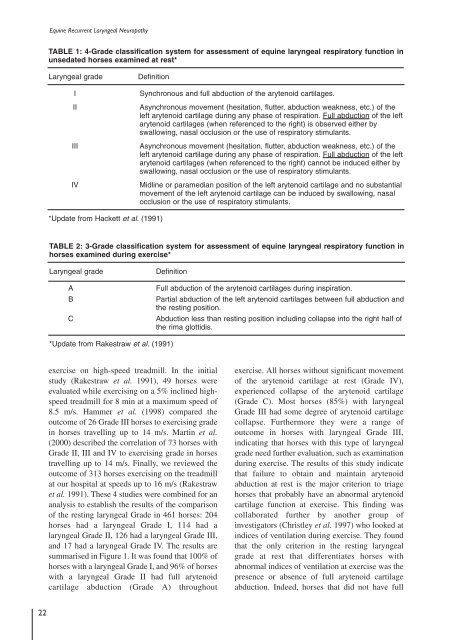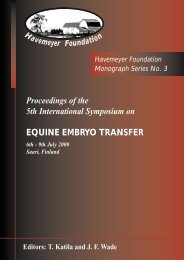Proceedings of a Workshop on - The Havemeyer Foundation
Proceedings of a Workshop on - The Havemeyer Foundation
Proceedings of a Workshop on - The Havemeyer Foundation
You also want an ePaper? Increase the reach of your titles
YUMPU automatically turns print PDFs into web optimized ePapers that Google loves.
Equine Recurrent Laryngeal Neuropathy<br />
TABLE 1: 4-Grade classificati<strong>on</strong> system for assessment <str<strong>on</strong>g>of</str<strong>on</strong>g> equine laryngeal respiratory functi<strong>on</strong> in<br />
unsedated horses examined at rest*<br />
Laryngeal grade<br />
I<br />
II<br />
III<br />
IV<br />
Definiti<strong>on</strong><br />
Synchr<strong>on</strong>ous and full abducti<strong>on</strong> <str<strong>on</strong>g>of</str<strong>on</strong>g> the arytenoid cartilages.<br />
Asynchr<strong>on</strong>ous movement (hesitati<strong>on</strong>, flutter, abducti<strong>on</strong> weakness, etc.) <str<strong>on</strong>g>of</str<strong>on</strong>g> the<br />
left arytenoid cartilage during any phase <str<strong>on</strong>g>of</str<strong>on</strong>g> respirati<strong>on</strong>. Full abducti<strong>on</strong> <str<strong>on</strong>g>of</str<strong>on</strong>g> the left<br />
arytenoid cartilages (when referenced to the right) is observed either by<br />
swallowing, nasal occlusi<strong>on</strong> or the use <str<strong>on</strong>g>of</str<strong>on</strong>g> respiratory stimulants.<br />
Asynchr<strong>on</strong>ous movement (hesitati<strong>on</strong>, flutter, abducti<strong>on</strong> weakness, etc.) <str<strong>on</strong>g>of</str<strong>on</strong>g> the<br />
left arytenoid cartilage during any phase <str<strong>on</strong>g>of</str<strong>on</strong>g> respirati<strong>on</strong>. Full abducti<strong>on</strong> <str<strong>on</strong>g>of</str<strong>on</strong>g> the left<br />
arytenoid cartilages (when referenced to the right) cannot be induced either by<br />
swallowing, nasal occlusi<strong>on</strong> or the use <str<strong>on</strong>g>of</str<strong>on</strong>g> respiratory stimulants.<br />
Midline or paramedian positi<strong>on</strong> <str<strong>on</strong>g>of</str<strong>on</strong>g> the left arytenoid cartilage and no substantial<br />
movement <str<strong>on</strong>g>of</str<strong>on</strong>g> the left arytenoid cartilage can be induced by swallowing, nasal<br />
occlusi<strong>on</strong> or the use <str<strong>on</strong>g>of</str<strong>on</strong>g> respiratory stimulants.<br />
*Update from Hackett et al. (1991)<br />
TABLE 2: 3-Grade classificati<strong>on</strong> system for assessment <str<strong>on</strong>g>of</str<strong>on</strong>g> equine laryngeal respiratory functi<strong>on</strong> in<br />
horses examined during exercise*<br />
Laryngeal grade<br />
A<br />
B<br />
C<br />
Definiti<strong>on</strong><br />
Full abducti<strong>on</strong> <str<strong>on</strong>g>of</str<strong>on</strong>g> the arytenoid cartilages during inspirati<strong>on</strong>.<br />
Partial abducti<strong>on</strong> <str<strong>on</strong>g>of</str<strong>on</strong>g> the left arytenoid cartilages between full abducti<strong>on</strong> and<br />
the resting positi<strong>on</strong>.<br />
Abducti<strong>on</strong> less than resting positi<strong>on</strong> including collapse into the right half <str<strong>on</strong>g>of</str<strong>on</strong>g><br />
the rima glottidis.<br />
*Update from Rakestraw et al. (1991)<br />
exercise <strong>on</strong> high-speed treadmill. In the initial<br />
study (Rakestraw et al. 1991), 49 horses were<br />
evaluated while exercising <strong>on</strong> a 5% inclined highspeed<br />
treadmill for 8 min at a maximum speed <str<strong>on</strong>g>of</str<strong>on</strong>g><br />
8.5 m/s. Hammer et al. (1998) compared the<br />
outcome <str<strong>on</strong>g>of</str<strong>on</strong>g> 26 Grade III horses to exercising grade<br />
in horses travelling up to 14 m/s. Martin et al.<br />
(2000) described the correlati<strong>on</strong> <str<strong>on</strong>g>of</str<strong>on</strong>g> 73 horses with<br />
Grade II, III and IV to exercising grade in horses<br />
travelling up to 14 m/s. Finally, we reviewed the<br />
outcome <str<strong>on</strong>g>of</str<strong>on</strong>g> 313 horses exercising <strong>on</strong> the treadmill<br />
at our hospital at speeds up to 16 m/s (Rakestraw<br />
et al. 1991). <strong>The</strong>se 4 studies were combined for an<br />
analysis to establish the results <str<strong>on</strong>g>of</str<strong>on</strong>g> the comparis<strong>on</strong><br />
<str<strong>on</strong>g>of</str<strong>on</strong>g> the resting laryngeal Grade in 461 horses: 204<br />
horses had a laryngeal Grade I, 114 had a<br />
laryngeal Grade II, 126 had a laryngeal Grade III,<br />
and 17 had a laryngeal Grade IV. <strong>The</strong> results are<br />
summarised in Figure 1. It was found that 100% <str<strong>on</strong>g>of</str<strong>on</strong>g><br />
horses with a laryngeal Grade I, and 96% <str<strong>on</strong>g>of</str<strong>on</strong>g> horses<br />
with a laryngeal Grade II had full arytenoid<br />
cartilage abducti<strong>on</strong> (Grade A) throughout<br />
exercise. All horses without significant movement<br />
<str<strong>on</strong>g>of</str<strong>on</strong>g> the arytenoid cartilage at rest (Grade IV),<br />
experienced collapse <str<strong>on</strong>g>of</str<strong>on</strong>g> the arytenoid cartilage<br />
(Grade C). Most horses (85%) with laryngeal<br />
Grade III had some degree <str<strong>on</strong>g>of</str<strong>on</strong>g> arytenoid cartilage<br />
collapse. Furthermore they were a range <str<strong>on</strong>g>of</str<strong>on</strong>g><br />
outcome in horses with laryngeal Grade III,<br />
indicating that horses with this type <str<strong>on</strong>g>of</str<strong>on</strong>g> laryngeal<br />
grade need further evaluati<strong>on</strong>, such as examinati<strong>on</strong><br />
during exercise. <strong>The</strong> results <str<strong>on</strong>g>of</str<strong>on</strong>g> this study indicate<br />
that failure to obtain and maintain arytenoid<br />
abducti<strong>on</strong> at rest is the major criteri<strong>on</strong> to triage<br />
horses that probably have an abnormal arytenoid<br />
cartilage functi<strong>on</strong> at exercise. This finding was<br />
collaborated further by another group <str<strong>on</strong>g>of</str<strong>on</strong>g><br />
investigators (Christley et al. 1997) who looked at<br />
indices <str<strong>on</strong>g>of</str<strong>on</strong>g> ventilati<strong>on</strong> during exercise. <strong>The</strong>y found<br />
that the <strong>on</strong>ly criteri<strong>on</strong> in the resting laryngeal<br />
grade at rest that differentiates horses with<br />
abnormal indices <str<strong>on</strong>g>of</str<strong>on</strong>g> ventilati<strong>on</strong> at exercise was the<br />
presence or absence <str<strong>on</strong>g>of</str<strong>on</strong>g> full arytenoid cartilage<br />
abducti<strong>on</strong>. Indeed, horses that did not have full<br />
22








